
The Khalistan movement is a separatist movement seeking to create a homeland for Sikhs by establishing an ethno‐religious sovereign state called Khalistan in the Punjab region. The proposed boundaries of Khalistan vary between different groups; some suggest the entirety of the Indian state of Punjab, while larger claims include Pakistani Punjab and other parts of North India such as Chandigarh, Haryana, and Himachal Pradesh. Shimla and Lahore have been proposed as the capital of Khalistan.
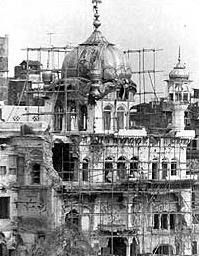
Operation Blue Star was an Indian Armed Forces operation between 1 and 10 June 1984 to remove Damdami Taksal Jathedar Jarnail Singh Bhindranwale and his followers from the buildings of the Golden Temple, the holiest site of Sikhism, in Amritsar, Punjab, India. The decision to launch the operation rested with the Prime Minister of India, then Indira Gandhi, who had already authorized military preparation for a confrontation at the temple complex 18 months prior according to the then-Vice Chief of the Army Staff, S. K. Sinha. In July 1982, Harchand Singh Longowal, the president of the Sikh political party Shiromani Akali Dal, had invited Bhindranwale to take up residence in the Golden Temple to evade arrest by government authorities.

The Central Reserve Police Force (CRPF) is a reserve gendarmerie and internal combat force in India under the authority of the Ministry of Home Affairs (MHA) of the Government of India. It is one among the Central Armed Police Forces. The CRPF's primary role lies in assisting the State/Union Territories in police operations to maintain law and order and counter-insurgency. It is composed of Central Reserve Police Force (Regular) and Central Reserve Police Force (Auxiliary).

The Indo-Pakistani War of 1947–1948, or the First Kashmir War, was a war fought between India and Pakistan over the princely state of Jammu and Kashmir from 1947 to 1948. It was the first of four Indo-Pakistani wars between the two newly independent nations. Pakistan precipitated the war a few weeks after its independence by launching tribal lashkar (militias) from Waziristan, in an effort to capture Kashmir and to preempt the possibility of its ruler joining India. The inconclusive result of the war still affects the geopolitics of both countries.
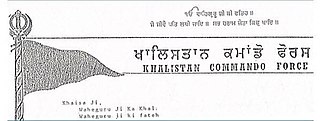
The Khalistan Commando Force (KCF) is a Sikh Khalistani organisation operating in the state of Punjab, India with prominent members based in Canada, United Kingdom and Pakistan. Its objective is the creation of a Sikh independent state of Khalistan through armed struggle. KCF is also responsible for many assassinations in India, including the 1995 assassination of Punjab Chief Minister Beant Singh. It was designated as a banned Terrorist Organisation by the Government of India.

The Insurgency in Punjab, India was an armed campaign by the militants of the Khalistan Movement from the mid-1980s to the mid-1990s. Terrorism, Police brutality and corruption of the authorities were the highlights of the insurgency and the aftermath of the 1984 Sikh Massacre. In the 1980s, the movement had evolved into a militant secessionist movement after the perceived indifference of the Indian state in regards to mutual negotiations. The demand for a separate Sikh state gained momentum after the Indian Army's Operation Blue Star in 1984 aimed to flush out militants residing in the Golden Temple in Amritsar, a holy site for Sikhs. The operation resulted in the deaths of many militants and civilians, as well as the destruction of the Golden Temple. In the mid-1990s, the insurgency petered out and the Khalistan Movement failed to reach its objective due to multiple reasons including a heavy police crackdown on civilians and militants and extrajudicial killing of Sikhs by Punjab Police and Indian Army. The militancy brought under the control of the law enforcement agencies by 1995.
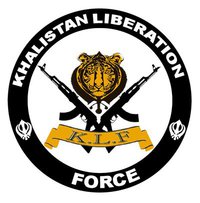
The Khalistan Liberation Force (KLF) is a Khalistani separatist militant organization based in the Indian state of Punjab. Its motive is the creation of a sovereign Sikh state called Khalistan via armed struggle. The KLF is one of the key fighting forces of the Khalistan Movement. It was responsible for assassinations, abductions and military engagements with the Indian Armed Forces during the Insurgency in Punjab. The KLF is listed as a designated terrorist group by India.

The Tat Khalsa, also romanised as Tatt Khalsa, known as the Akal Purkhias during the 18th century, was a Sikh faction that arose from the schism following the passing of Guru Gobind Singh in 1708, led by his widow Mata Sundari, opposed to the religious innovations of Banda Singh Bahadur and his followers. The roots of the Tat Khalsa lies in the official formalization and sanctification of the Khalsa order by the tenth Guru in 1699.

The Dashmesh Regiment was a militant group, and is part of the Khalistan movement to create a Sikh homeland called Khalistan via armed struggle. The Dashmesh Regiment jathebandi group has claimed responsibility for two of the killings in the 2016–17 Targeted killings in Punjab, India. The origins, leadership, and existence of Dasmesh Regiment is hazy. Some believe it was created by a third-party to put blame of their activities of Jarnail Singh. The Dasmesh Regiment first leader is alleged to be Surinder Singh Gill or Harminder Singh Sandhu the general secretary of the AISSF. Sandhu had admitted to his leadership of the regiment, but also denied it. Some say that it was led by Major General Shabeg Singh. Another belief holds that Dashmesh Regiment was a borad name used by the media to pin responsibility for crimes. It is known that Seetal Singh Mattewal created a militant group in 1990 with the name of Dashmesh Regiment and was its head.

Sukhdev Singh Dhillon, best known as General Labh Singh and also known as Sukha Sipahi and just Labh Singh, was a former Punjab police officer turned militant who took command of the Khalistan Commando Force after its first leader, Manbir Singh Chaheru, was arrested in 1986.
The April 2010 Dantewada Maoist attack was an 6 April 2010 ambush by Naxalite-Maoist insurgents from the Communist Party of India (Maoist) near Chintalnar village in Dantewada district, Chhattisgarh, India, leading to the killing of 76 CRPF policemen and 8 Maoists — the deadliest attack by the Maoists on Indian security forces.
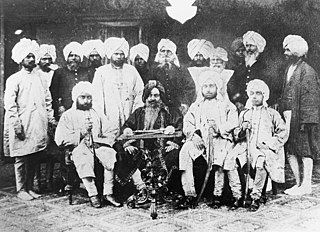
The Amritsar Singh Sabha, popularly known as Sanatan Singh Sabha, was founded in 1873, "It was essentially original and Sanatan ('eternal'). The Sanatan Sikh were the traditional Sikhs who were eventually marginalised.

Gurjant Singh Budhsinghwala was the third chief of the Khalistan Liberation Force.
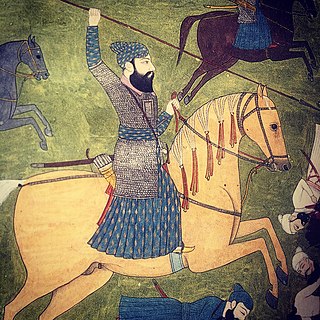
Banda Singh Bahadur, was a Sikh warrior and a commander of the Khalsa army. At age 15, he left home to become an ascetic, and was given the name Madho Das Bairagi. He established a monastery at Nānded, on the bank of the river Godāvarī. In 1707, Guru Gobind Singh accepted an invitation to meet Bahadur Shah I in southern India, he visited Banda Singh Bahadur in 1708. Banda became disciple of Guru Gobind Singh and was given a new name, Gurbaksh Singh(as written in Mahan Kosh), after the baptism ceremony. He is popularly known as Banda Singh Bahadur. He was given five arrows by the Guru as a blessing for the battles ahead. He came to Khanda, Sonipat and assembled a fighting force and led the struggle against the Mughal Empire.

The 1978 Sikh-Nirankari clash occurred between the Sant Nirankari Mission and Sikhs of Damdami Taksal and Akal Kirtani Jatha on 13 April 1978 at Amritsar, Punjab, India. Sixteen people—thirteen traditional Sikhs and three Nirankari followers—were killed in the ensuing violence, occurring when some Akhand Kirtani Jatha and Damdami Taksal members led by Fauja Singh protested against and tried to stop a convention of Sant Nirankari Mission followers. This incident is considered to be a starting point in the events leading to Operation Blue Star and the 1980s insurgency in Punjab.

Jugraj Singh, better known as Toofan Singh, was a militant member of the Khalistan Liberation Force who was born in 1971 in Sri Hargobindpur, Punjab, India. According to police records, he was allegedly involved in 150 killings. He was killed in an encounter on April 8, 1990.

Indian Armed Forces in Jammu and Kashmir encompass the Indian Army, Navy and Air Force, tri-service units such as the Armed Forces Special Operations Division (AFSOD), and paramilitary organisations of the Central Armed Police Forces such as the Border Security Force, the Central Reserve Police Force, the Sashastra Seema Bal and the Indo-Tibetan Border Police. Each three wings of India's military have their special forces deployed in the region including Indian Army's Para SF, the Indian Navy MARCOS and the Indian Air Force's Garud Commando Force. Apart from this, there is the elite police anti-insurgency force in the region, the Special Operations Group, of the Jammu and Kashmir Police.
Avtar Singh Brahma, also known as "JathedarAvtar Singh Ji Brahma" was one of the main founding figures and the second leader of the Kharku militant organization known as Khalistan Liberation Force founded in 1986. He became known as a Robin Hood figure. Avtar Singh has been reputed for never attacking civilians.
Operation Mand was a military operation launched by India to capture or kill Avtar Singh Brahma and Tat Khalsa members on July 21 and 22, 1986.















